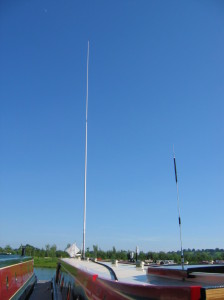The diagrams included in this article were modelled with a program called MMANA. If you are inclined to give this a go, its a free download and I have produced training films on YouTube.
NOTE: I have intentionally modelled the vertical antenna with a bad ground to replicate the findings of some fibreglass yacht owners who run a 15 to 20 foot copper ground strap to Dynaplates. I have modelled the horizontal antennas over sea-water.
This article follows my paper on raised feedpoint vertical SSB antennas for fibreglass boats. In this article, I look at an alternative; a horizontal dipole antenna which I will call an offset doublet and a Mk2 version, with a vertical component at the rear. We will continue to use the ATU matching device (often supplied by Icom) which will remove all the hassle of mono-banding and tuning. Marine SSB relies on a number of frequencies so an ATU to dial out the mismatch is vital.

 Close inspection showed that the antenna is a 2-piece 28’6″ (8.5 meter or thereabouts) white fibreglass hollow pole with a 2 foot aluminium heavy-duty sleeve at the base for mounting purposes. This main lower section (of around 17 feet or so) has three elements running the full length embedded inside the fibreglass at time of manufacture from the side feed to the top, in 120 degree arc segments. A heavy-duty male screw fitting at the top, electrically connects to the top section’s female thread.
Close inspection showed that the antenna is a 2-piece 28’6″ (8.5 meter or thereabouts) white fibreglass hollow pole with a 2 foot aluminium heavy-duty sleeve at the base for mounting purposes. This main lower section (of around 17 feet or so) has three elements running the full length embedded inside the fibreglass at time of manufacture from the side feed to the top, in 120 degree arc segments. A heavy-duty male screw fitting at the top, electrically connects to the top section’s female thread.